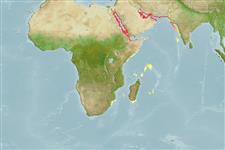>
Gobiiformes (Gobies) >
Gobiidae (Gobies) > Gobiinae
Etymology: Trimma: Greek, trimma, -atos = something crushed (Ref. 45335).
Environment: milieu / climate zone / depth range / distribution range
Οικολογία
Θαλασσινό(ά) Υφαλόφιλο(α); εύρος βάθους 8 - 12 m (Ref. 13694). Tropical
Western Indian Ocean: Gulf of Aqaba to the Gulf of Tadjoura, Djibouti, Gulf of Aden.
Μέγεθος / Βάρος / Age
Maturity: Lm ? range ? - ? cm
Max length : 2.4 cm SL αρσενικό/απροσδιόριστο; (Ref. 28618); μεγ. δημοσιευμένο βάρος: 0.12 g (Ref. 131019)
Life cycle and mating behavior
Maturities | Αναπαραγωγή | Spawnings | Egg(s) | Fecundities | Προνύμφες
Winterbottom, R., 1995. Red Sea gobiid fishes of the genus Trimma, with the description of two new species. Rev. Fr. Aquariol. 22(3-4):93-98. (Ref. 13694)
IUCN Red List Status (Ref. 130435)
Threat to humans
Harmless
Human uses
Εργαλεία
Special reports
Download XML
Διαδικτυακές πηγές
Estimates based on models
Preferred temperature (Ref.
123201): 25 - 29.2, mean 28 °C (based on 267 cells).
Phylogenetic diversity index (Ref.
82804): PD
50 = 0.5000 [Uniqueness, from 0.5 = low to 2.0 = high].
Bayesian length-weight: a=0.01023 (0.00477 - 0.02194), b=3.02 (2.84 - 3.20), in cm total length, based on LWR estimates for this (Sub)family-body shape (Ref.
93245).
Ελαστικότητα (Ref.
120179): Υψηλό, ελάχιστος χρόνος για διπλασιασμό πληθυσμού < 15 μήνες (Preliminary K or Fecundity.).
Fishing Vulnerability (Ref.
59153): Low vulnerability (10 of 100).
